Every now and then, I come across a life sciences company’s website that immediately hooks me. It doesn’t happen often, but when it does, it’s impossible to ignore.
Today, I want to introduce you to one of those companies—Lindus Health. They caught my attention with a clever "anti-marketing" approach. In this article, we’re going to dive into their homepage and compare it to a more traditional competitor, so you can see firsthand how great marketing can impact customers.
You can check out their homepage here, but before you do, stick with me for a bit and let's analyse it together.
Lindus’ anti-marketing slogan
Lindus is one of the rare examples of anti-marketing I have seen in life sciences, and that’s why I think it deserves a full analysis.
Anti-marketing consists of deliberately positioning a brand as being against the typical approach of its industry. Anti-marketing often seeks to subvert expectations, appeal to consumers' skepticism of marketing, or present the brand as more authentic and transparent (or sometimes more humorous).
The core idea is to challenge the norm and play with the "curiosity gap" created by an unexpected message (I’ve written about this concept here).
One famous example of anti-marketing is Patagonia’s “Don’t buy this jacket” campaign:

In 2011, Patagonia ran this ad in The New York Times on Black Friday, asking people to buy their products only when they really need them, a position that reflected their eco-conscious values and lifetime product warranties.
Lindus Health uses a similar approach to grab attention with its bold, unexpected messaging right at the top of its homepage, in a section we call the "hero."
If you’re not familiar with the term, a hero is basically the first thing you see when you land on a website. It’s the section “above the fold,” meaning you don’t need to scroll to see it (the opposite is “below the fold”). The hero usually consists of a visual element (background, image, video, etc.), some text, and a call-to-action (CTA).
The more impactful the copywriting, the better, because the goal of the hero is always to hook the visitor.
Now let’s look at our two examples, starting with the hero of Lindus Health:
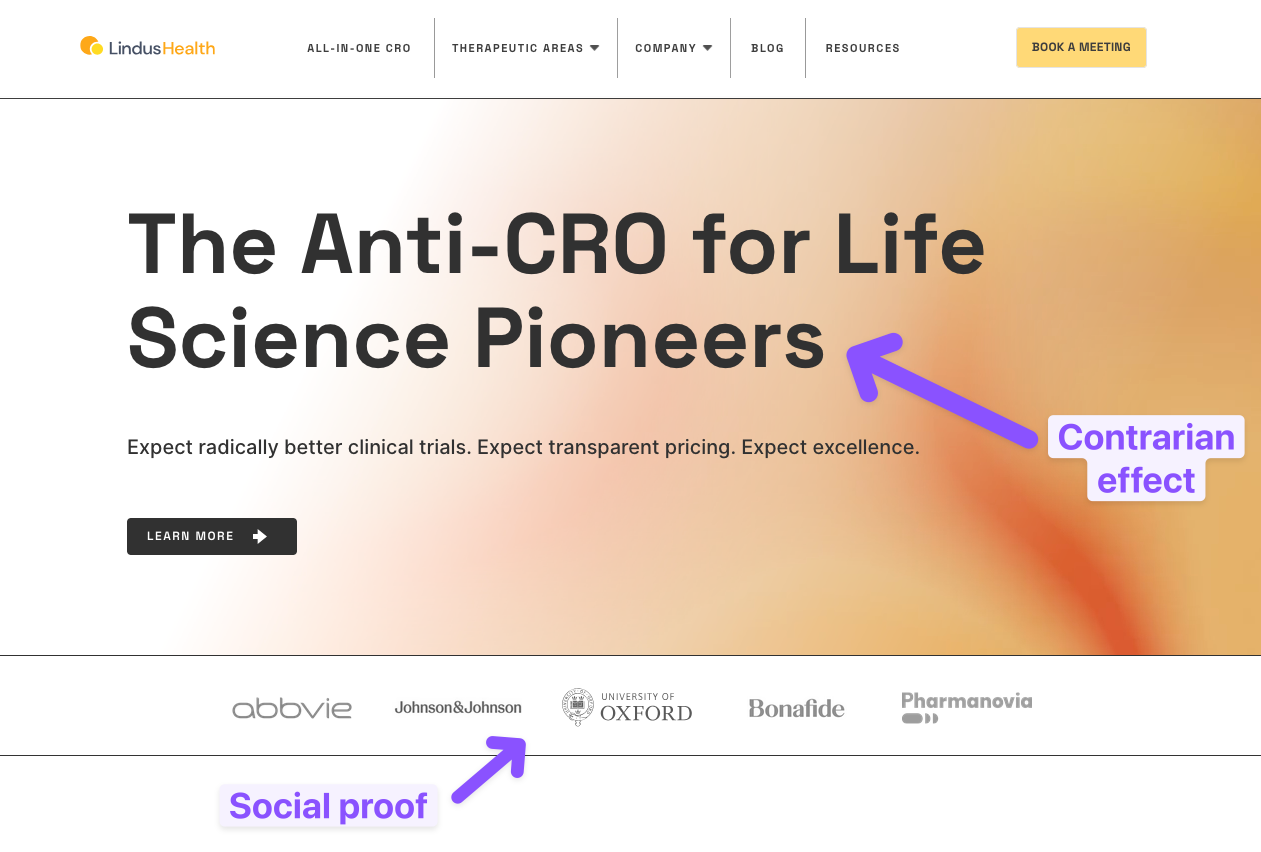
Do you see how they use anti-marketing?
It's just with those two words: "Anti-CRO".
For those in biopharma, the struggle to find a reliable CRO (Contract Research Organization) is familiar, so a company that positions itself as the “Anti-CRO” is bound to stand out.
This is where the anti-marketing comes in. By claiming to be the "anti-CRO", Lindus is positioning itself as rebellious and fundamentally different from competitors, even if it's still doing the same core work. It creates an appealing narrative for consumers who might be frustrated with traditional CROs.
This taps into two psychological effects:
- Reactance: When people feel their freedom of choice is limited by conventional options, they often react by seeking alternatives. Lindus taps into this by positioning itself as the refreshing “anti” choice.
- Ingroup-outgroup bias: The company creates a division where they are part of the "ingroup" of modern and transparent CROs, while others are in the "outgroup" of traditional, opaque practices. This bias influences people to align with the "ingroup," because they want to be part of something cooler.
This tactic basically leads to strong emotional engagement with the brand.
To reinforce this, the hero section ends with a series of logos—using “social proof” to build credibility (we’ll cover this in more detail later).
Now, let’s compare this to a more traditional CRO, such as IQVIA Biotech (sorry in advance to the company for picking them, there are literally dozens of similar examples out there, so don’t take it personally):
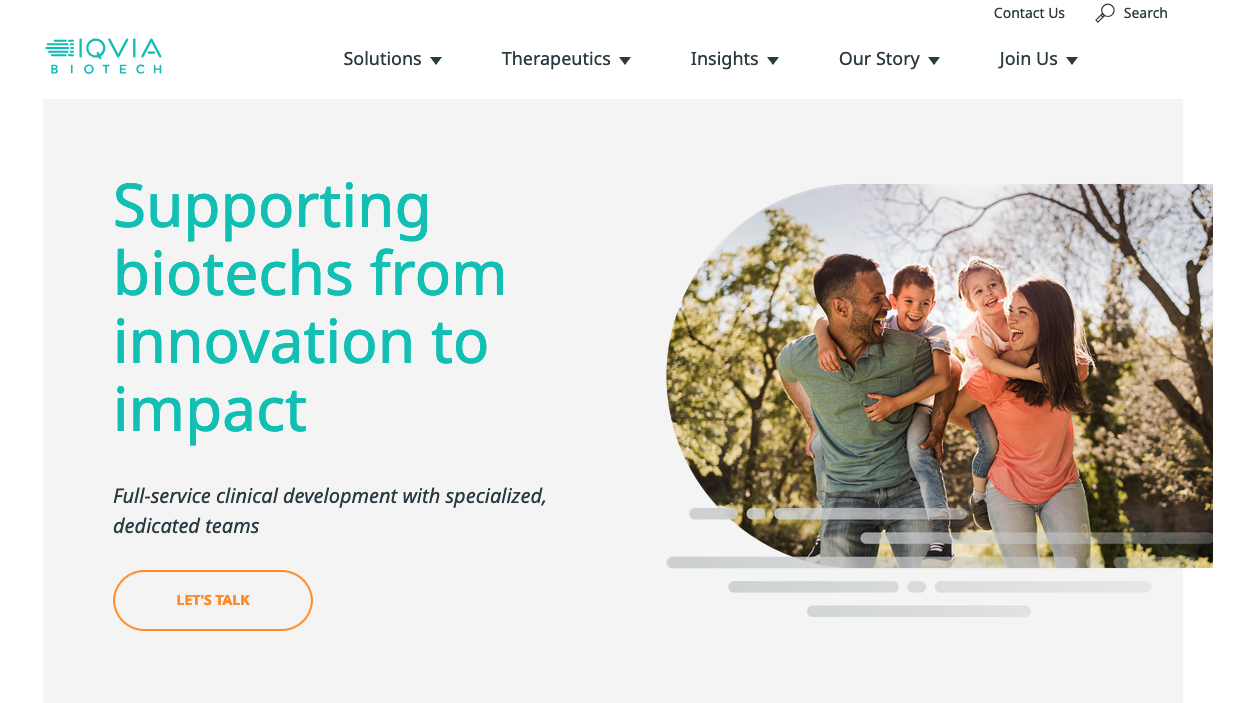
While IQVIA’s hero section isn’t bad, it doesn’t stand out. The text is generic and similar to what you'd find on most CRO websites (like this one, or this one). It doesn’t have the same hook or sense of intrigue that Lindus achieves. Most visitors would likely just scroll down without giving it a second thought.
I could basically end my analysis here because, with this simple copywriting technique, Lindus Health has already won your attention for the long term, while other competitors will barely be noticed.
But let's scroll down their homepage to find out what other techniques they use.
Using social proof effectively
Now let's talk a little bit about social proof because Lindus Health does it really well.
Social proof is the psychological phenomenon where people tend to follow the actions and decisions of others, especially when they're uncertain about what to do. It’s the idea that if other people are doing something, it must be the right thing to do. Essentially, it’s the "if everyone else likes it, I will too" effect.
In marketing, social proof works by showing potential customers that others (especially people similar to them) trust, use, and endorse a product or service. This helps build credibility and reduce doubt. There are several categories of social proof, such as customer reviews, testimonials, influencer endorsements, certifications, or high metrics.
Lindus Health uses social proof brilliantly. As we saw earlier, they start by displaying well-known client logos right at the top of the page. Seeing these big pharma names immediately increases trust in what this “Anti-CRO” claims to offer.
But they don’t stop there. Just below the fold, they reinforce the effect with client reviews:
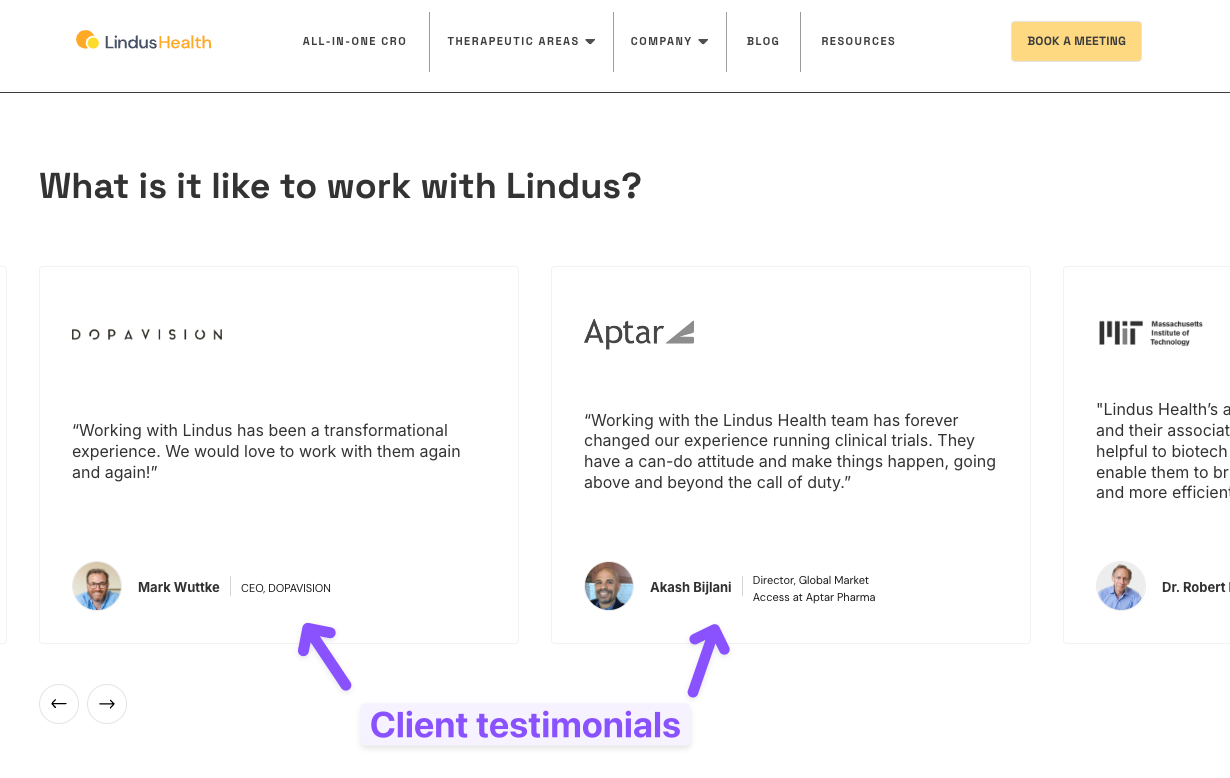
And further down the page, they add yet another layer of social proof by showcasing their advisory board:
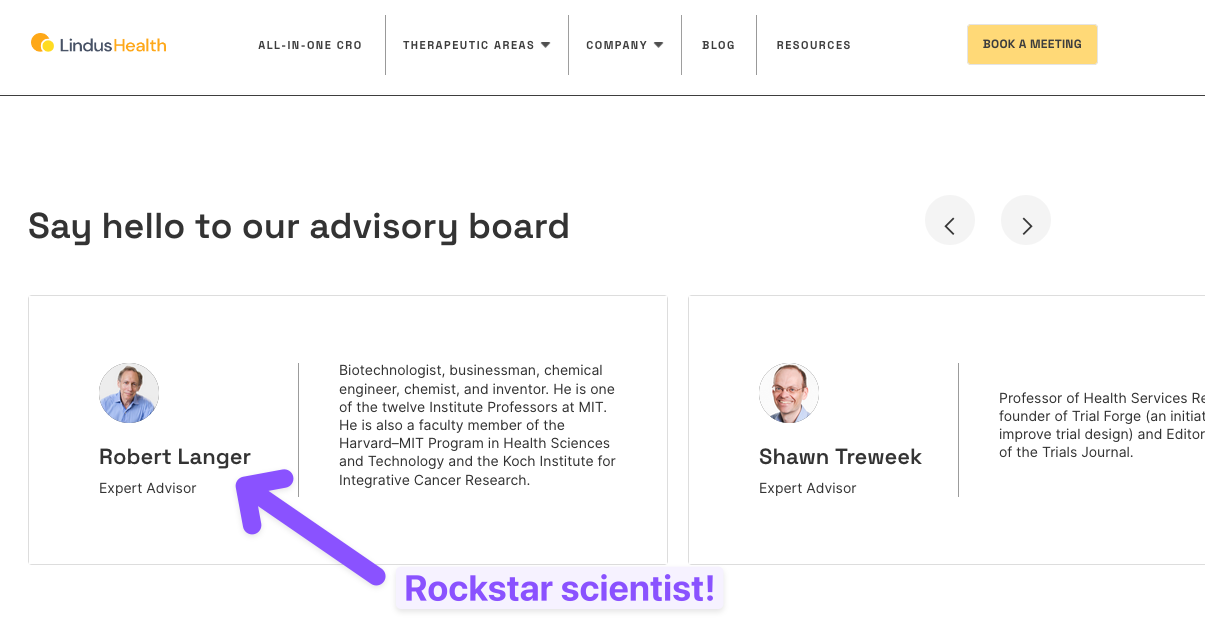
This section really hits the mark because one name stands out—Robert Langer. He’s a household name in the biotech industry, renowned as the most cited engineer in history and one of the 10 most cited individuals in any field. Plus, he’s co-founded over 40 biotech companies, including Moderna.
The presence of someone as credible as Langer on their advisory board is a massive trust booster.
My only critique here is that Lindus also uses Robert Langer in their client testimonials, which can feel redundant. It creates a slight bias when you notice it—something they could easily fix by removing his testimonial while keeping him in the advisory board section.
In comparison, IQVIA Biotech doesn’t feature any social proof on its homepage, and you can really feel the difference. Lindus hooked me with its bold "Anti-CRO" claim and then amplified that effect with strong social proof. IQVIA, on the other hand, feels much more forgettable in this regard.
I still don't understand why so few companies use social proof. It's really easy to implement and has been proven time and time again to be an effective strategy.
What's harder, however, is building a website that does the selling without any effort. And on that front, Lindus once again comes out on top.
Copywriting 101: Addressing common customer objections
In this section, I’ll analyze the rest of Lindus Health’s homepage, which skillfully addresses potential customer objections—a fundamental technique in effective copywriting.
Let’s start with the section just below the client testimonials:
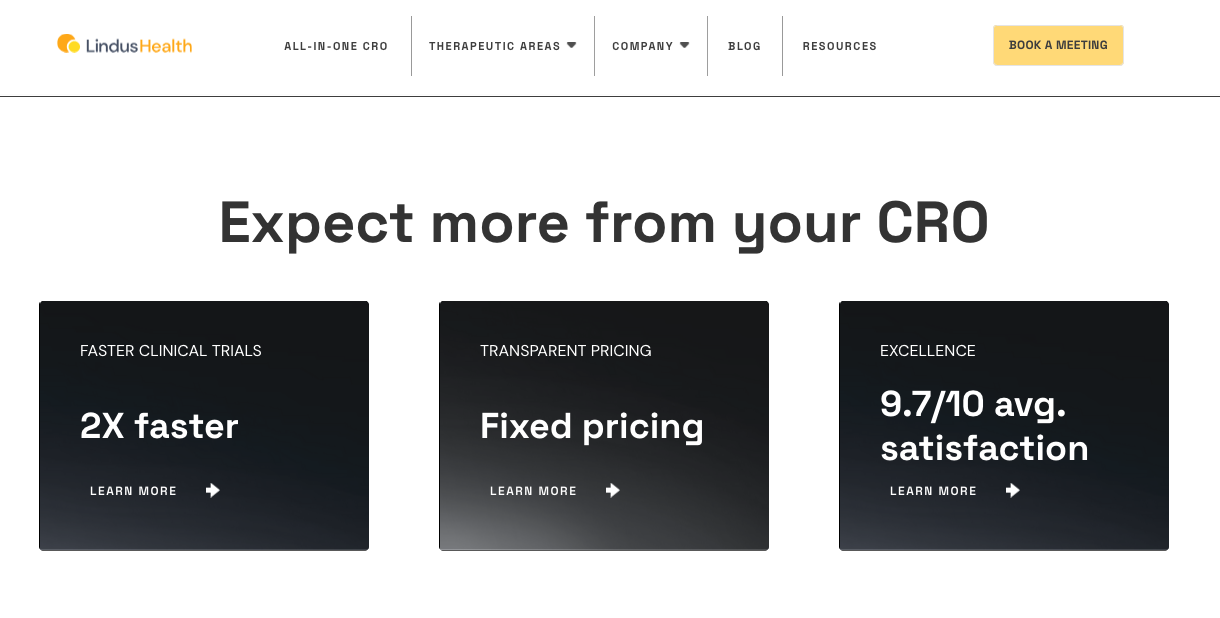
This part is a clever mix of social proof (like the satisfaction score) and sales arguments designed to address common objections.
The arguments of "2X faster" and "fixed pricing" perfectly complement Lindus’ anti-marketing strategy by addressing two of the most common pain points clients have with CROs—slowness and unpredictable costs.
Traditional CROs often face complaints about sluggish timelines, which can delay clinical trials and eat into a company's budget and time-to-market goals. By directly countering this with "2X faster," Lindus positions itself as the more efficient alternative, playing into the idea that they are rejecting the industry's typical inefficiencies.
The second objection, opaque pricing, is another common grievance. Traditional CROs often have pricing structures tied to complex processes or unpredictable results, which can spiral out of control. By offering "fixed pricing," Lindus is taking the unpredictability out of the equation, reinforcing its stance as a transparent and client-friendly "anti-CRO."
On the other hand, IQVIA Biotech doesn’t adopt this strategy. Here’s what they feature just below the fold:
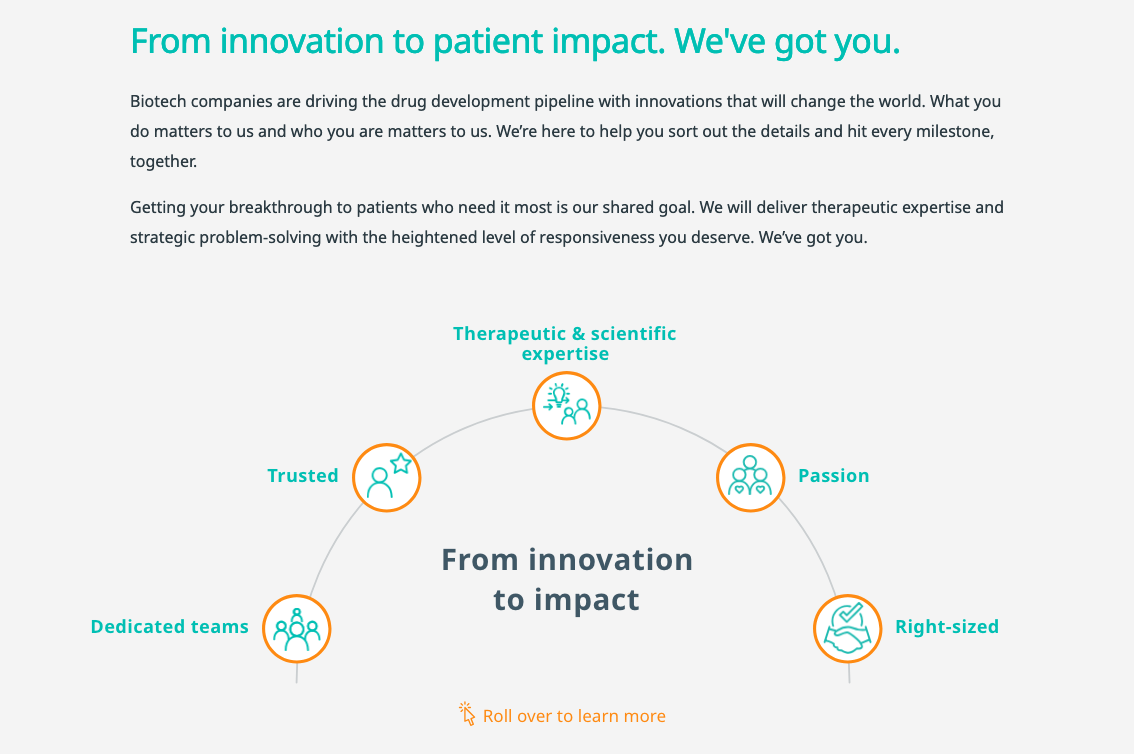
While it’s not terrible, it’s also quite generic, and that makes it forgettable.
Lindus really nails it when it comes to sales argument on their homepage.
Further down their page, you’ll find this section:
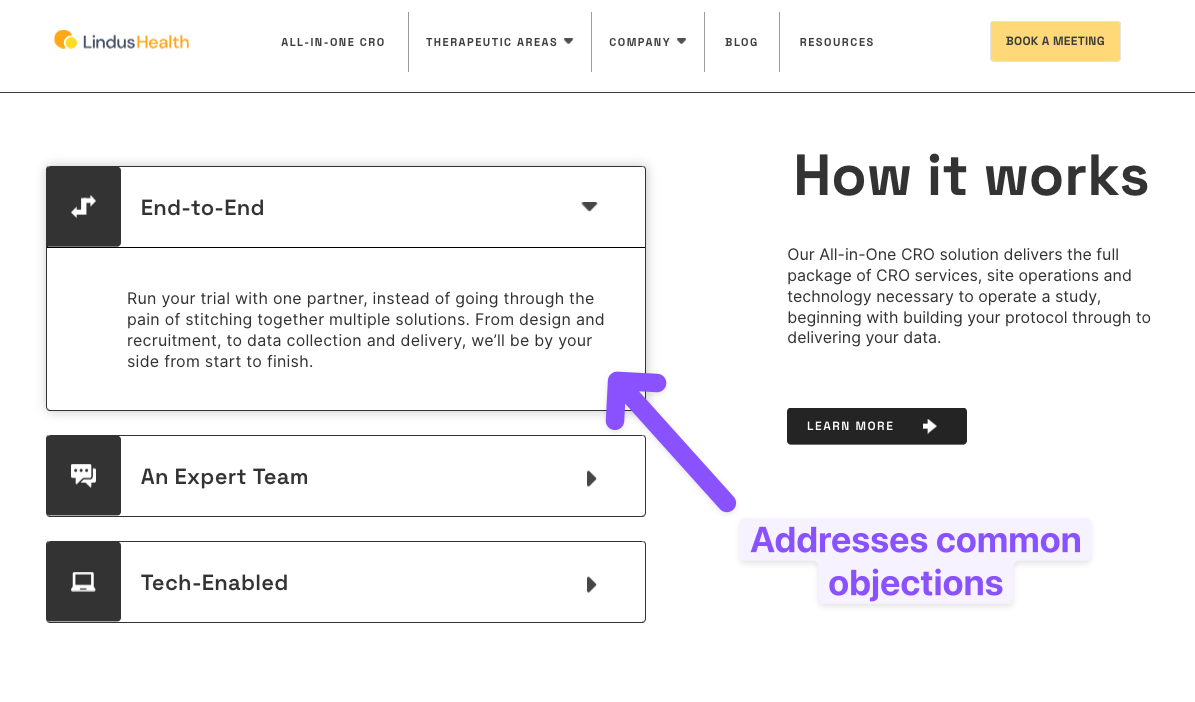
This short and direct piece addresses three other common concerns people have about CROs. But that’s not all.
One of Lindus’ selling points is that they are an “all-in-one” solution, and to reinforce this idea, they use a comparison table:

Tables like these can deal a knockout blow to competitors by clearly positioning Lindus as the superior choice. However, I think this particular table could be even stronger. The content feels a bit misleading, as many traditional CROs now offer “all-in-one” solutions, too.
A more impactful approach would be to name actual competitors and highlight their limitations. Directly naming competitors can be aggressive but incredibly effective. You just have to be careful with your claims, using only publicly available information to ensure fairness, but if you truly offer a better product, this tactic is a no-brainer.
Lindus also uses other effective copywriting techniques. They feature a section showing their international footprint—a critical selling point for CROs—and a section with team headshots, which helps “humanize” the brand:
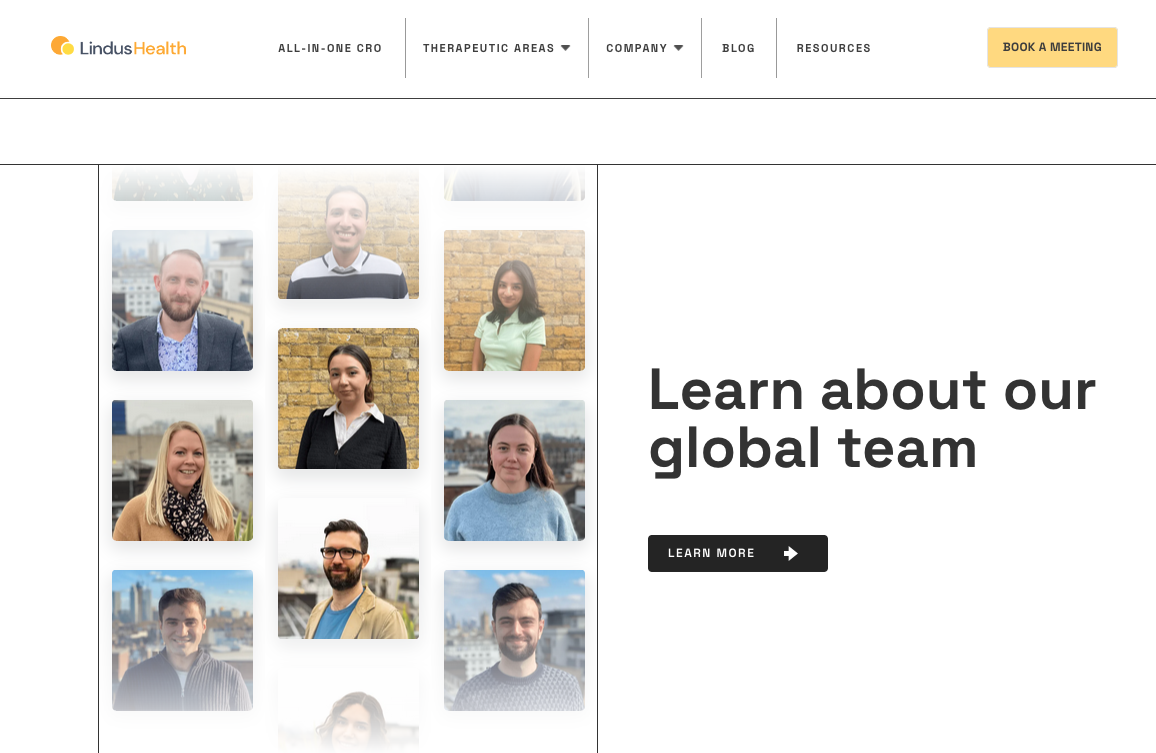
Notice how almost none of the team members are wearing suits? It’s a subtle but effective use of the anti-marketing approach. Most CRO websites showcase executives in pristine suits, so when you see a bunch of people who look relaxed and approachable, it feels refreshing.
IQVIA Biotech, however, doesn’t make nearly as good use of its homepage real estate.
Most of the remaining sections on the homepage are filled with generic content that fails to make them stand out.
Just take a look at this:
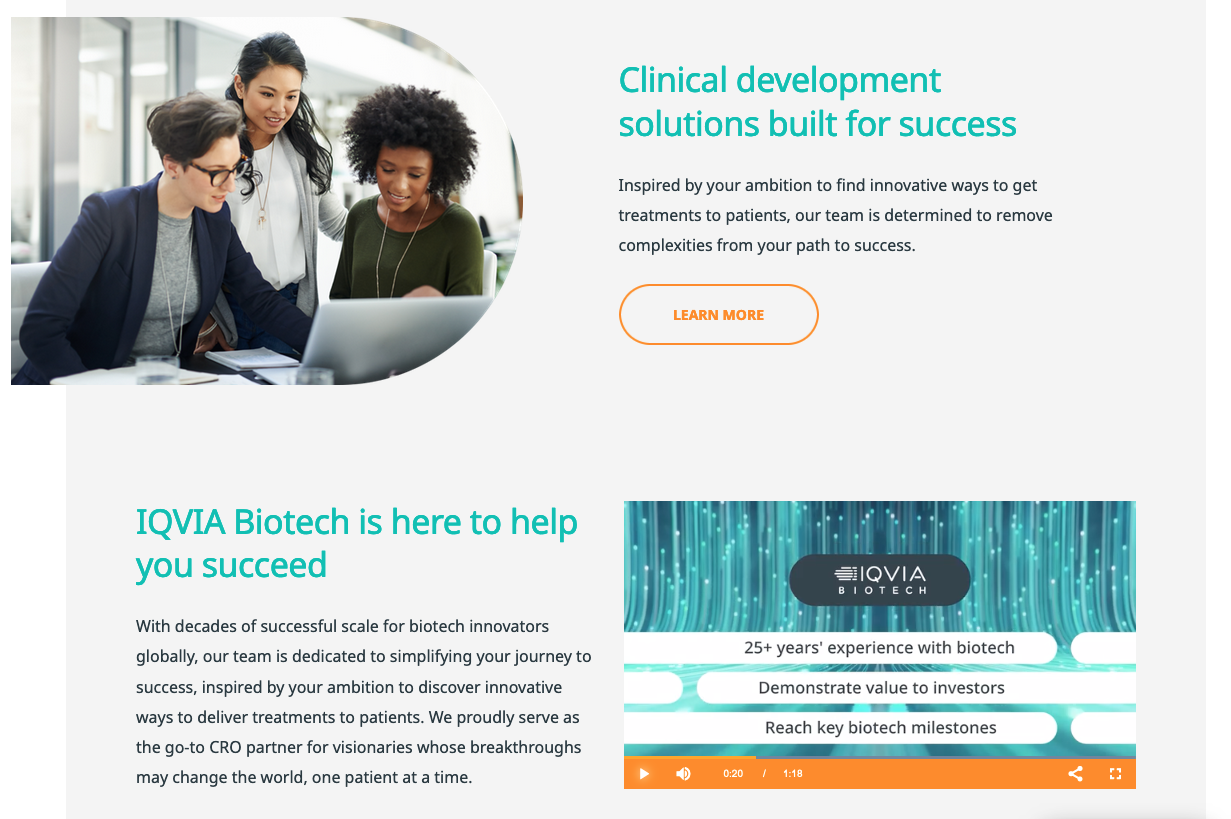
It’s full of buzzwords and vague messaging that doesn’t communicate anything specific. The sections below aren’t much better: they include a large area displaying their therapeutic focuses (information that’s already available in the menu), an event carousel (a good idea in theory, but poorly executed), and links to content that lack visual appeal.
Once again, Lindus Health comes out on top, but there is always room for improvement, and I have a few suggestions.
What could Lindus Health improve on its homepage?
I've already mentioned a few elements Lindus could improve to make their site even better, but here are a few more things I noticed:
- Replace the hero text with stronger messaging
The "About us" page of Lindus Health does a great job at presenting a more detailed and compelling argument for their "Anti-CRO" stance:
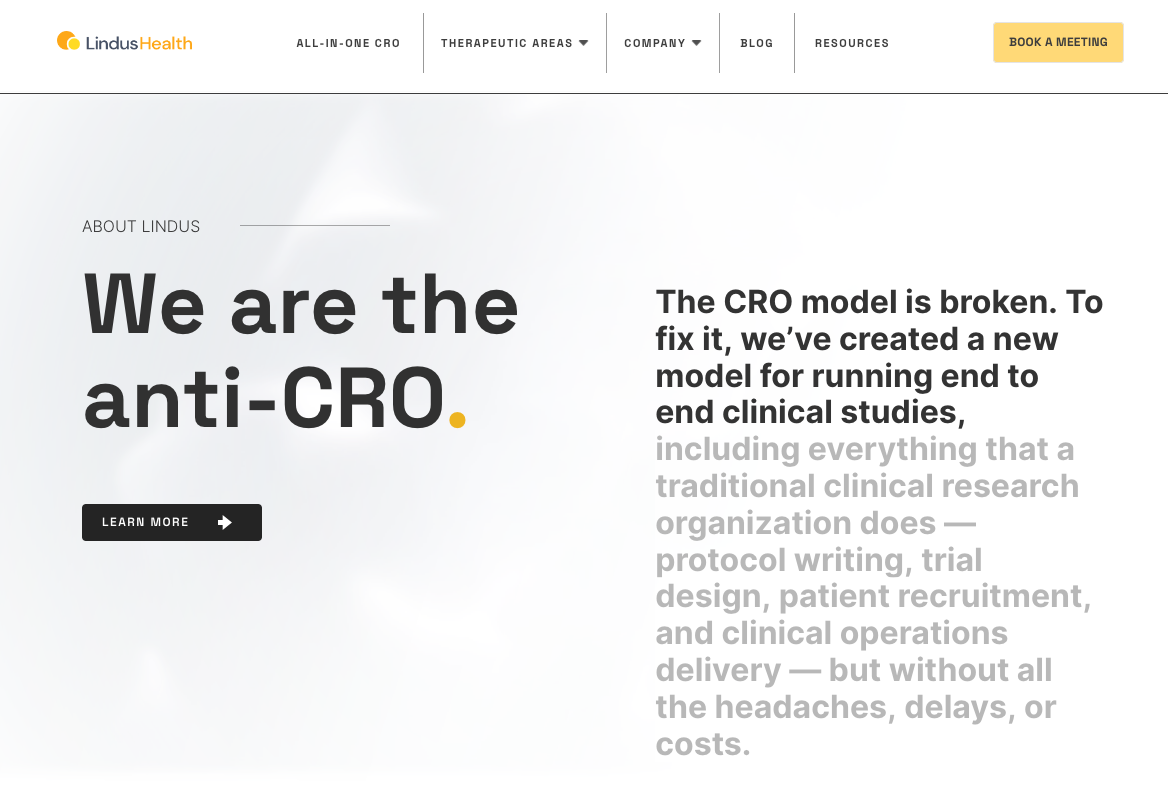
By testing this more engaging and informative text in the hero section of the homepage, Lindus could further captivate their audience right from the start. This would give visitors a deeper understanding of what sets them apart, creating a clearer value proposition in the first few seconds. Running an A/B test would allow them to measure its effectiveness against the initial copy.
- Make the newsletter more prominent
Lindus has a newsletter, but the only way to subscribe is buried at the bottom of the page in the footer, as if they don't want you to see it:
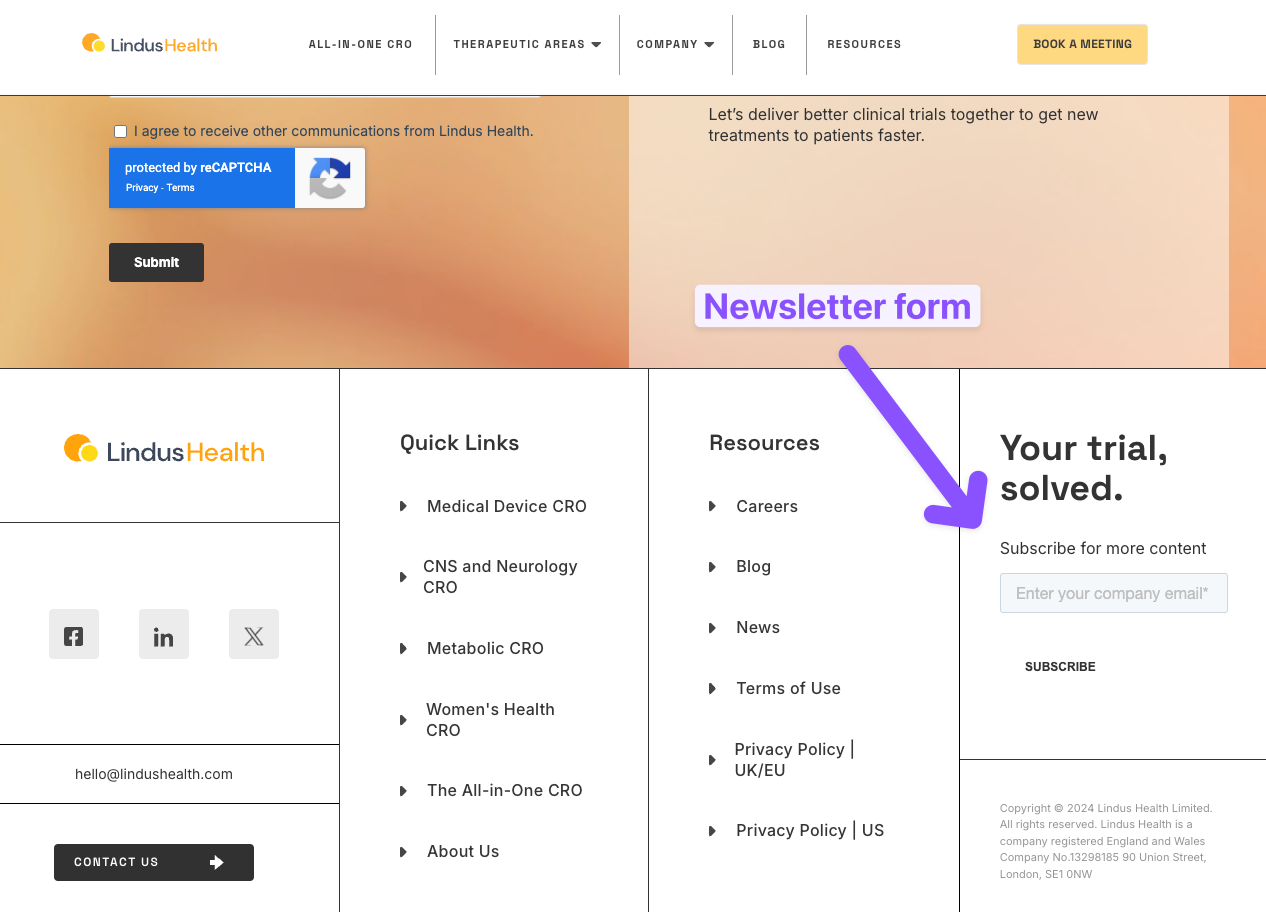
I think that's a missed opportunity, especially with the kind of attitude they have. Lindus is clearly a "rebel CRO" that goes against the norm, so they could capitalize on that by putting even more effort into producing content that makes them stand out.
Here are a few ways Lindus could promote the newsletter more effectively:
- Add a signup form in the hero section: Using the newsletter as a call-to-action right from the start could be a good way to capture many more leads and nurture them over time.
- Incorporate it into blog posts: Lindus' blog posts don't even have a newsletter signup form. Placing it at the top and the end of each blog post could capitalize on readers who are already interested in their content.
- Create a pop-up: An exit-intent pop-up with a brief but compelling message (e.g., “Accelerate your clinical trials with our unconventional insights”) could help capture readers' attention before they leave the site.
- Leverage the blog and thought leadership content
While their blog content is good, Lindus could go a step further by promoting it more prominently on the homepage. By positioning themselves as a resource for industry insights, they can draw in both potential clients and industry professionals who are still in search of a CRO. The newsletter and blog could also be tied together to create a more cohesive content strategy that drives repeat visits and builds brand trust.
If Lindus makes a few tweaks to these elements, they could make their homepage even more powerful and persuasive, which would help them stand out even more in the market.
In a nutshell, Lindus Health stands out as a CRO that uses an anti-marketing strategy to set itself apart in a competitive industry. I've barely scratched the surface of their marketing and only looked at their homepage, but I can say that it's one of the few examples I find truly impressive in life sciences.
If you liked this post and would like to see more similar case studies, please let me know. I’m always on the lookout for more interesting case studies, so also feel free to drop me a line if you have an example you'd like me to analyze.





